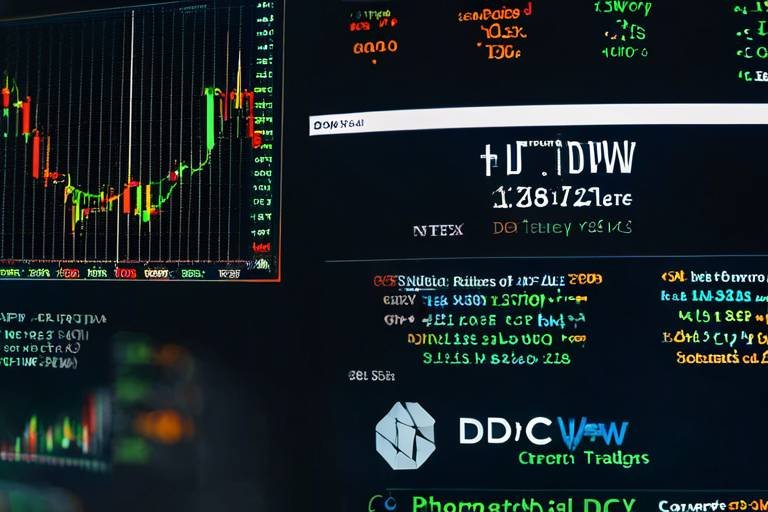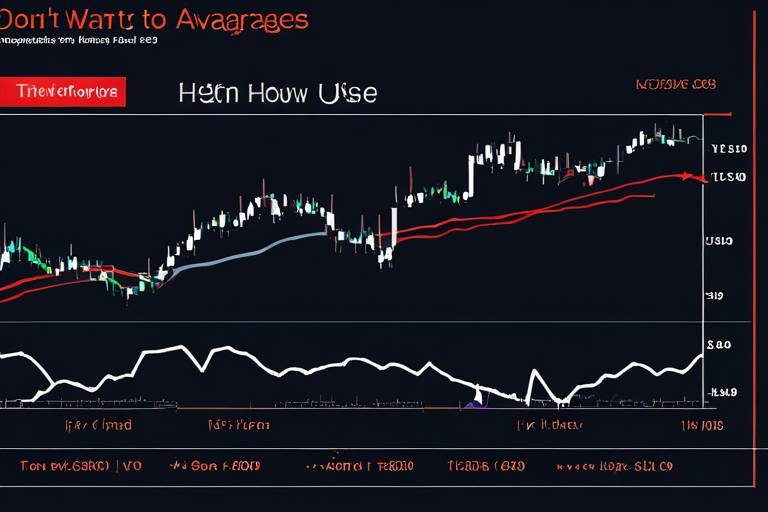Understanding the Impact of External Factors on Crypto Markets
The world of cryptocurrency is like a thrilling roller coaster ride, full of ups and downs, twists and turns that can leave even the most seasoned investors feeling dizzy. But what really drives this ride? The answer lies in the myriad of external factors that influence the crypto markets. In this article, we will delve into how economic indicators, regulatory changes, technological advancements, and social trends shape the landscape of cryptocurrencies. Understanding these factors is crucial for anyone looking to navigate the often turbulent waters of crypto investing.
Let's kick things off with economic indicators. Think of these as the pulse of the economy, providing vital signs that can affect investor confidence and market liquidity. For instance, inflation rates can serve as a double-edged sword. When inflation rises, the value of fiat currencies often declines, leading investors to seek refuge in cryptocurrencies as a hedge against losing purchasing power. Similarly, unemployment figures and GDP growth can sway investor sentiment dramatically. When the economy is booming, people feel more secure, and they may be more willing to invest in riskier assets like cryptocurrencies.
Now, let’s talk about the regulatory landscape. This is where things can get a bit murky. Different countries have different approaches to cryptocurrency regulation, and these regulations can either foster growth or stifle innovation. Imagine trying to play a game where the rules keep changing; that’s how crypto investors often feel. For example, a country might suddenly impose strict regulations on cryptocurrency trading, leading to a significant drop in market activity. On the flip side, a government that embraces cryptocurrency can create a vibrant market environment.
Government policies are a crucial aspect of this regulatory framework. Policies regarding taxation and cryptocurrency usage can either create a welcoming environment or one fraught with obstacles. For example, if a government decides to tax cryptocurrency transactions heavily, it could discourage trading and investment, leading to a decrease in market liquidity. Conversely, favorable tax policies can encourage more investors to enter the market.
International regulations add another layer of complexity. Countries like China have taken a hard stance against cryptocurrencies, while others, like El Salvador, have embraced them. This disparity can lead to market fragmentation, where different regions have vastly different trading volumes and investor participation. It’s like trying to play a game with players who are following different sets of rules.
Moreover, compliance with evolving regulations can impose additional costs on crypto businesses. These costs can affect operational capabilities and, ultimately, market performance. Companies might have to invest significant resources to ensure they are compliant, which can divert funds away from innovation and growth.
Market sentiment is another powerful force in the crypto world. Public perception can drive trends, often influenced by news, social media, and influential figures. For instance, a tweet from a well-known figure can send a cryptocurrency soaring or crashing within minutes. This volatility creates a dynamic environment where investor behavior can shift rapidly, making it essential for investors to stay informed and engaged.
Moving on to technological advancements, these innovations can significantly impact crypto markets. Improvements in blockchain technology and security enhancements can increase efficiency and reduce fraud. For example, scalability solutions aim to improve transaction speeds and reduce fees, making cryptocurrencies more viable for everyday transactions. Imagine trying to use a currency that takes hours to confirm a transaction—nobody would want to use it!
Scalability solutions are crucial for enhancing the adoption of cryptocurrencies among users and merchants. When transactions can be processed quickly and at a low cost, it opens up new possibilities for everyday use, driving market growth.
Advancements in security protocols are equally important. They help protect investors and their assets, fostering trust in cryptocurrency systems. When investors feel secure about their investments, they are more likely to participate actively in the market, contributing to its overall stability.
Finally, let’s explore the impact of social trends. The rise of decentralized finance (DeFi) and non-fungible tokens (NFTs) has reshaped the crypto landscape. These trends have created new investment opportunities and influenced market directions. Community engagement plays a vital role here. A strong community can drive the success of particular cryptocurrencies, fostering loyalty among investors and enhancing market resilience during downturns.
When a community rallies behind a cryptocurrency, it can create a sense of belonging and commitment that helps sustain its value. This community-driven support can be a game-changer, especially in volatile markets.
The influence of key figures and social media personalities cannot be underestimated. Their opinions can sway public sentiment and investment trends, leading to rapid shifts in market dynamics. It’s like having a celebrity endorse a product; their influence can make or break a cryptocurrency in a matter of days.
- What are the main external factors affecting crypto markets? Economic indicators, regulatory changes, technological advancements, and social trends are the primary external factors.
- How do government policies influence cryptocurrency? Government policies can create a favorable or unfavorable environment for cryptocurrency trading and investment.
- Why is market sentiment important in crypto? Market sentiment can drive significant price movements and influence investor behavior.
- What role do technological advancements play? Technological advancements improve efficiency, security, and scalability, which can enhance market growth.

Economic Indicators
When we talk about the cryptocurrency market, it’s essential to recognize that it doesn’t exist in a vacuum. Just like a tree relies on the soil and weather to grow, cryptocurrencies are deeply influenced by various economic indicators. These indicators, including inflation rates, unemployment figures, and GDP growth, play a pivotal role in shaping investor sentiment and market dynamics.
For instance, imagine you’re at a party, and the music suddenly changes from upbeat to somber. Your mood shifts, right? Similarly, when inflation rates rise, it can create a sense of uncertainty among investors. A high inflation rate often leads to a decline in purchasing power, prompting investors to seek alternative assets like cryptocurrencies as a hedge against inflation. This shift can drive demand and, subsequently, prices upward. Conversely, when inflation is low, investors may feel more confident in traditional markets, which can divert attention away from crypto investments.
Now, let’s talk about unemployment figures. High unemployment can signal economic distress, leading to a lack of consumer spending and investment. In such times, people are less likely to invest in volatile assets like cryptocurrencies. On the flip side, when unemployment rates drop and the economy is thriving, there’s generally more disposable income available. This can lead to increased investments in cryptocurrencies, as people feel more financially secure and willing to take risks.
Another crucial indicator is Gross Domestic Product (GDP) growth. A growing GDP indicates a healthy economy, which tends to boost investor confidence. When the economy is booming, more people are likely to invest in various assets, including cryptocurrencies. However, if GDP growth slows or enters negative territory, it can create a ripple effect, leading to reduced investment in riskier assets like crypto. As a result, understanding these economic indicators is vital for anyone looking to navigate the tumultuous waters of the crypto market.
To illustrate the relationships between these economic indicators and their potential impacts on the crypto market, here’s a simple table:
| Economic Indicator | Impact on Crypto Market |
|---|---|
| Inflation Rates | Increased demand for cryptocurrencies as a hedge against inflation. |
| Unemployment Figures | High unemployment can lead to reduced investment in cryptocurrencies. |
| GDP Growth | Higher GDP growth typically boosts investor confidence, leading to increased crypto investments. |
In conclusion, economic indicators are like the weather forecast for the cryptocurrency market. They can help investors anticipate changes and make informed decisions. By keeping an eye on these indicators, you can better understand the market's shifting tides and position yourself accordingly. So, the next time you hear about inflation or GDP growth, remember that these numbers could very well influence your crypto investments!
- What are economic indicators? Economic indicators are statistics that provide information about the economic performance of a country, helping to gauge the overall health of the economy.
- How do inflation rates affect cryptocurrency? High inflation can lead investors to seek alternative assets like cryptocurrencies to protect their purchasing power.
- Can unemployment figures influence crypto investments? Yes, high unemployment can decrease consumer spending and investment, leading to reduced interest in cryptocurrencies.
- What role does GDP growth play in the crypto market? A growing GDP typically boosts investor confidence, which can lead to increased investments in cryptocurrencies.

Regulatory Changes
Regulatory developments across the globe are like the winds that shape the landscape of cryptocurrency. They can either propel the market forward or push it back, depending on the nature of the regulations introduced. When a country announces a new set of rules regarding cryptocurrency trading, it can send ripples through the entire market, influencing investor sentiment and behavior. For instance, if a nation embraces cryptocurrencies with open arms, it can lead to a surge in investment and trading activities, while restrictive regulations can create an environment of uncertainty and fear.
One of the most significant aspects of regulatory changes is how they affect government policies. Taxation policies, for example, can either encourage or deter investment in cryptocurrencies. If a government decides to impose heavy taxes on crypto gains, investors might think twice before diving into the market, fearing that their profits will be significantly diminished. Conversely, a favorable tax regime can attract more investors, driving prices upward and enhancing market liquidity.
Government policies regarding cryptocurrency usage can create an environment that either fosters growth or stifles innovation. For instance, countries that support blockchain technology and provide a clear regulatory framework often see a boom in crypto startups and innovations. This creates a vibrant ecosystem where businesses can thrive, leading to a more robust market. On the other hand, countries that impose strict regulations or outright bans can push innovation underground, stifling growth and leading to a fragmented market.
International regulations also play a crucial role in shaping the crypto landscape. Different countries have varying approaches to cryptocurrency regulation, which can lead to market fragmentation. For example, while one country may embrace cryptocurrencies and allow them to be used for transactions, another may ban them altogether. This disparity can affect global trading volumes and investor participation, as traders often seek markets where they can operate freely without regulatory hurdles.
Compliance with evolving regulations can impose additional costs on crypto businesses. These costs can come from the need to hire legal experts, implement new technologies to ensure compliance, or even from fines imposed for non-compliance. Such financial burdens can impact a company's operational capabilities, ultimately affecting market performance. As a result, many businesses may choose to relocate to more favorable regulatory environments, further influencing market dynamics.
In conclusion, regulatory changes are a double-edged sword in the world of cryptocurrencies. They can either pave the way for a thriving market or create obstacles that hinder growth. As the landscape continues to evolve, investors must stay informed about these changes and adapt their strategies accordingly. Understanding the regulatory environment is crucial for navigating the often volatile waters of cryptocurrency trading.
- What are the main factors influencing cryptocurrency regulations? Regulatory changes are influenced by economic conditions, technological advancements, and public sentiment towards cryptocurrencies.
- How do regulatory changes affect investor sentiment? Regulatory changes can create uncertainty or confidence in the market, directly impacting investor behavior and market trends.
- What are the consequences of non-compliance with regulations? Non-compliance can lead to hefty fines, legal issues, and a loss of credibility in the market.

Government Policies
Government policies play a pivotal role in shaping the cryptocurrency landscape. When we think about how these policies can influence the market, it's essential to recognize that they can either create a nurturing environment for innovation or impose restrictive measures that hinder growth. For instance, countries that embrace cryptocurrencies by providing clear regulatory frameworks often see a surge in investment and development within their crypto ecosystems. This is akin to planting a seed in fertile soil; with the right conditions, it can flourish and yield substantial returns.
On the other hand, when governments impose heavy taxation or overly stringent regulations, it can create a chilling effect on the market. Investors may become hesitant, fearing that their gains will be heavily taxed or that they could face legal repercussions for engaging in crypto transactions. This uncertainty can lead to decreased market participation and a decline in overall investor confidence. Think of it as trying to swim upstream; the more obstacles there are, the harder it becomes to make progress.
Additionally, government policies regarding the use of cryptocurrencies can significantly influence market dynamics. For example, if a government decides to accept cryptocurrency for tax payments or public services, it could enhance the legitimacy of digital currencies and encourage broader adoption. Conversely, outright bans or restrictions can lead to market fragmentation, pushing users to less regulated environments, which can complicate trading and investment strategies.
To illustrate the impact of these policies, consider the following table that outlines various government approaches to cryptocurrency:
| Country | Policy Type | Impact on Crypto Market |
|---|---|---|
| United States | Regulatory Clarity | Encourages innovation and investment |
| China | Ban on Mining | Leads to market downturn and migration |
| El Salvador | Legal Tender | Boosts adoption and investment |
| India | Proposed Taxation | Creates uncertainty and hesitance among investors |
In summary, government policies can either pave the way for a thriving cryptocurrency market or create significant barriers to entry. Investors must remain vigilant, keeping an eye on regulatory developments that could impact their investments. Just like navigating through a dense forest, understanding the terrain of government policies can help investors make informed decisions that lead to success in the ever-evolving world of cryptocurrencies.
- What are the main factors that influence government policies on cryptocurrencies? Government policies are influenced by economic conditions, public sentiment, and the perceived risks associated with cryptocurrencies.
- How can I stay updated on changes in cryptocurrency regulations? Following reputable news sources, government announcements, and industry reports can help you stay informed.
- What should I consider before investing in cryptocurrencies given the regulatory landscape? It's crucial to understand the regulatory environment in your country, including potential taxes and compliance requirements.

International Regulations
When it comes to the world of cryptocurrency, can feel like navigating through a maze. Each country has its own approach to how cryptocurrencies are treated, which can lead to a complex landscape for investors and businesses alike. Imagine trying to play a game where the rules change depending on where you are standing—this is the reality for crypto traders operating in a global market.
For instance, some countries have embraced cryptocurrencies, crafting regulations that promote innovation and adoption. Others, however, have opted for a more cautious approach, implementing strict rules that can hinder market growth. This divergence can create significant challenges, especially for businesses looking to operate across borders. When regulations differ so widely, it can lead to market fragmentation, where investors may find it more difficult to trade or invest in certain cryptocurrencies based on their location.
To illustrate this point, consider the following table that outlines the regulatory stance of various countries:
| Country | Regulatory Stance | Impact on Crypto Market |
|---|---|---|
| United States | Mixed (state and federal regulations) | High compliance costs, but significant investment opportunities |
| China | Restrictive | Limited market participation, but innovation in blockchain technology |
| El Salvador | Proactive (Bitcoin as legal tender) | Increased adoption and investment, but risks of volatility |
| European Union | Regulatory framework in development | Potential for harmonized regulations, fostering market stability |
This table highlights how the regulatory environment can directly impact market behavior. For example, in the United States, the mixed regulatory landscape can create high compliance costs for businesses, which may deter some from entering the market. On the flip side, it also opens up significant investment opportunities for those willing to navigate the complexities.
Moreover, international regulations can affect global trading volumes. When countries impose stringent rules, it can reduce the number of participants in the market, leading to decreased liquidity and increased volatility. Investors often seek out jurisdictions that offer a more favorable regulatory environment, which can shift trading volumes away from heavily regulated markets.
In conclusion, understanding international regulations is crucial for anyone involved in the cryptocurrency space. These regulations not only shape how cryptocurrencies are traded but also influence investor sentiment and market dynamics. As the landscape continues to evolve, staying informed about regulatory changes across different countries will be key to making wise investment decisions.
- What are international regulations in cryptocurrency? International regulations refer to the various laws and guidelines set by different countries regarding the use and trading of cryptocurrencies.
- How do international regulations impact cryptocurrency markets? They can create fragmentation in the market, affect liquidity, and influence investor participation based on the regulatory environment of each country.
- Why do some countries have stricter regulations than others? Countries may have different economic priorities, risk assessments, and levels of technological adoption, leading to varying approaches to cryptocurrency regulation.
- What should investors consider regarding international regulations? Investors should stay informed about the regulatory landscape in their country and other regions to understand the potential risks and opportunities in the crypto market.

Compliance Requirements
Compliance with evolving regulations is a critical aspect that crypto businesses must navigate to thrive in the competitive landscape. As governments and regulatory bodies introduce new laws and guidelines, companies are often faced with the challenge of adapting their operations to meet these requirements. This can impose additional costs, which may affect their overall performance and market presence. For instance, firms may need to invest in legal counsel, compliance software, and training programs for their employees to ensure they are well-informed about the latest regulations.
Moreover, the complexity of compliance can vary significantly depending on the jurisdiction. Different countries have distinct regulatory frameworks that govern cryptocurrency activities, leading to a fragmented market. This inconsistency can make it challenging for businesses that operate internationally, as they must tailor their compliance strategies to align with local laws while maintaining a cohesive global strategy. For example, a company based in the United States may encounter different requirements compared to one in Europe or Asia, which can complicate cross-border transactions.
In addition to the financial implications, non-compliance can result in severe penalties, including hefty fines, legal action, or even the shutdown of operations. This risk underscores the importance of staying updated on regulatory changes and being proactive in compliance efforts. Companies that prioritize compliance not only protect themselves from potential repercussions but also build trust with their customers and investors. A strong compliance record can enhance a company's reputation, making it more attractive to potential investors who seek stability and reliability in the often-volatile crypto market.
Furthermore, compliance requirements can also influence market dynamics. When businesses are unable to comply with regulations, it can lead to a decrease in market participation, ultimately affecting liquidity and trading volumes. As compliance becomes more stringent, smaller players may struggle to keep up, leading to a consolidation of market power among larger, more established firms. This shift can create a less competitive environment, which may hinder innovation and growth within the industry.
In summary, navigating compliance requirements is no small feat for crypto businesses. It involves a careful balancing act of adhering to regulations while striving for growth and innovation. As the crypto landscape continues to evolve, staying ahead of compliance challenges will be crucial for companies aiming to succeed in this dynamic market.
- What are compliance requirements in the crypto industry?
Compliance requirements refer to the laws and regulations that cryptocurrency businesses must follow to operate legally within their jurisdictions. These can include anti-money laundering (AML) and know your customer (KYC) regulations, among others. - Why is compliance important for crypto businesses?
Compliance is vital because it helps protect businesses from legal repercussions, builds trust with customers, and fosters a stable market environment. Non-compliance can lead to fines, legal actions, and reputational damage. - How do compliance requirements vary by country?
Different countries have unique regulatory frameworks governing cryptocurrencies, which can create challenges for businesses operating in multiple jurisdictions. Companies must tailor their compliance strategies to meet local laws. - What are the consequences of non-compliance?
Non-compliance can result in severe penalties, including fines, legal action, or the shutdown of operations. It can also damage a company's reputation and deter potential investors.

Market Sentiment
Market sentiment plays a pivotal role in the cryptocurrency landscape, often acting as the driving force behind price movements and investor behavior. It's fascinating how public perception can sway entire markets, almost like a ripple effect in a pond. When investors feel optimistic, they tend to buy more, pushing prices up; conversely, when fear sets in, panic selling can lead to a steep decline. This emotional rollercoaster is fueled by various factors, including news headlines, social media buzz, and the opinions of influential figures in the crypto space.
One of the most interesting aspects of market sentiment is its volatility. Unlike traditional markets, where sentiment may be swayed by economic indicators or corporate earnings reports, the crypto market is often influenced by real-time information disseminated through platforms like Twitter, Reddit, and Telegram. For instance, a single tweet from a well-known figure can send prices soaring or crashing within minutes. This rapid reaction to information creates an environment where investor psychology is paramount, making it essential for traders to keep their fingers on the pulse of social trends and news cycles.
Additionally, the rise of decentralized finance (DeFi) and non-fungible tokens (NFTs) has introduced new dynamics to market sentiment. These innovations have not only attracted a broader audience but have also sparked discussions about the future of finance and ownership. As more people engage with these concepts, their perceptions of cryptocurrencies evolve, leading to shifts in investment strategies. For example, if a new NFT project gains traction, it can create a buzz that impacts the overall sentiment towards the crypto market, encouraging more investors to explore and invest in various cryptocurrencies.
To illustrate the impact of market sentiment, consider the following table that highlights key events and their effects on cryptocurrency prices:
| Event | Date | Price Movement |
|---|---|---|
| Bitcoin ETF Approval | October 2021 | +20% |
| Tesla Accepts Bitcoin | February 2021 | +15% |
| China Bans Crypto Mining | June 2021 | -30% |
As you can see, significant events can lead to dramatic shifts in market sentiment and, subsequently, cryptocurrency valuations. This relationship between sentiment and price highlights the importance of understanding not just the numbers, but also the emotions and perceptions that drive investor behavior.
In conclusion, keeping a finger on the pulse of market sentiment is crucial for anyone involved in cryptocurrency trading or investing. By staying informed and understanding the emotional factors at play, investors can better navigate the often tumultuous waters of the crypto market, making more informed decisions that align with their investment strategies.
- What is market sentiment in cryptocurrency?
Market sentiment refers to the overall attitude of investors toward a particular cryptocurrency or the market as a whole, often influenced by external factors such as news, social media, and influential figures. - How does social media influence market sentiment?
Social media platforms can rapidly disseminate information and opinions, leading to quick shifts in public perception and investor behavior, which can significantly impact cryptocurrency prices. - Can market sentiment lead to volatility?
Yes, the emotional nature of market sentiment can cause rapid price fluctuations, leading to increased volatility in the cryptocurrency market. - How can I gauge market sentiment?
Investors can gauge market sentiment through various methods, including monitoring social media trends, analyzing news coverage, and observing trading volumes and price movements.

Technological Advancements
In the fast-paced world of cryptocurrency, play a pivotal role in shaping market dynamics. Innovations like blockchain enhancements and security upgrades are not just buzzwords; they are the backbone of a thriving crypto ecosystem. As the technology evolves, it brings about greater efficiency, security, and ultimately, a more robust market that attracts both seasoned investors and newcomers alike. The impact of these advancements can be likened to upgrading from a bicycle to a high-speed train—suddenly, what was once a slow and cumbersome process becomes streamlined and accessible.
One of the most significant technological leaps in the crypto space is the development of scalability solutions. These solutions aim to tackle the age-old problem of transaction speed and cost. Imagine trying to buy coffee with a cryptocurrency that takes ten minutes to confirm your transaction—frustrating, right? Scalability solutions like the Lightning Network for Bitcoin or Ethereum's transition to a proof-of-stake model are designed to enhance transaction throughput while keeping fees low. This means that cryptocurrencies become more practical for everyday use, fostering greater adoption among merchants and consumers.
Furthermore, security enhancements are crucial in building trust and confidence in cryptocurrency systems. With the rise of cyber threats and hacking incidents, ensuring the safety of investors’ assets is more important than ever. Innovations such as multi-signature wallets, decentralized identity solutions, and smart contract audits serve to protect users and their investments. When investors feel secure, they are more likely to participate actively in the market, contributing to its growth and stability. Think of these security measures as a well-guarded vault—only those with the right keys can access the treasures within, thus ensuring that the assets remain safe from prying eyes.
Moreover, the integration of decentralized finance (DeFi) platforms has revolutionized how financial services are delivered, offering everything from lending to trading without the need for traditional intermediaries. This shift not only democratizes access to financial services but also opens up new avenues for investment and innovation. As DeFi continues to evolve, it encourages a more inclusive financial ecosystem where anyone with an internet connection can participate. This is akin to bringing banking services to remote areas where traditional banks have never set foot—empowering individuals and communities alike.
To summarize, the impact of technological advancements on cryptocurrency markets is profound and multi-faceted. From scalability solutions that enhance transaction efficiency to security measures that build trust, each innovation contributes to a more vibrant and resilient market. As we continue to witness these developments, it’s clear that the future of cryptocurrency is not just about the coins themselves but the technology that underpins them.
- What are scalability solutions in cryptocurrency?
Scalability solutions refer to technological improvements that enhance the speed and efficiency of cryptocurrency transactions, making them more viable for everyday use. - How do security enhancements affect cryptocurrency?
Security enhancements protect investors' assets from cyber threats, fostering trust and encouraging more people to engage in the cryptocurrency market. - What is decentralized finance (DeFi)?
DeFi refers to financial services delivered on blockchain platforms without traditional intermediaries, allowing anyone to access services like lending and trading.

Scalability Solutions
When it comes to cryptocurrencies, scalability is a hot topic that can make or break a digital asset's usability. Imagine trying to squeeze a gallon of water through a garden hose—it's simply not going to work efficiently. The same principle applies to blockchain networks. As more users join the crypto space and transactions increase, the need for becomes paramount. Without these solutions, networks can become congested, leading to slow transaction speeds and high fees, which can deter users from adopting cryptocurrencies for everyday transactions.
There are several innovative scalability solutions currently being developed and implemented across various blockchain platforms. One of the most talked-about solutions is the implementation of Layer 2 protocols. These protocols operate on top of existing blockchains, allowing for faster and cheaper transactions while maintaining the security of the underlying network. For example, the Lightning Network for Bitcoin and Optimistic Rollups for Ethereum are both designed to enhance transaction throughput without sacrificing decentralization.
Moreover, sharding is another promising scalability solution that divides the blockchain into smaller, more manageable pieces, or "shards." Each shard can process its transactions and smart contracts, which significantly increases the network's overall capacity. This approach not only improves speed but also allows the network to handle a larger number of users without compromising performance.
In addition to these solutions, some projects are exploring the concept of sidechains. A sidechain is a separate blockchain that is attached to the main blockchain through a two-way peg, allowing assets to move between the two. This enables the main blockchain to offload some of its transactions to the sidechain, thus enhancing scalability. For instance, projects like Liquid Network are utilizing sidechains to facilitate quicker transactions for Bitcoin.
However, while scalability solutions are essential for the growth of cryptocurrencies, they also come with their own set of challenges. For example, implementing Layer 2 solutions can introduce complexities in terms of user experience and security. Users need to understand how to interact with these systems, which can be a barrier to entry for the average person. Additionally, there are concerns about the potential for centralization, as some Layer 2 solutions may rely on a smaller number of validators.
In conclusion, scalability solutions are crucial for the future of cryptocurrencies. As the industry continues to evolve, the development and adoption of these solutions will play a significant role in determining which cryptocurrencies thrive and which ones fall by the wayside. It's an exciting time in the crypto space, and the innovations happening around scalability are sure to shape the landscape for years to come.
- What are scalability solutions in the context of cryptocurrencies?
Scalability solutions refer to various technologies and methodologies aimed at increasing the transaction throughput of a blockchain network, allowing it to handle more transactions efficiently. - Why is scalability important for cryptocurrencies?
Scalability is vital because as more users join a network, the demand for transactions increases. Without scalability, networks can become congested, leading to slow transactions and higher fees, which can deter adoption. - What are Layer 2 protocols?
Layer 2 protocols are solutions built on top of existing blockchains that enable faster and cheaper transactions while maintaining the security of the underlying blockchain. - What is sharding?
Sharding is a scalability technique that divides a blockchain into smaller pieces, or shards, allowing each shard to process its transactions independently, thereby increasing the overall capacity of the network. - How do sidechains work?
Sidechains are separate blockchains that are attached to the main blockchain through a two-way peg, allowing for the transfer of assets between the two and helping to offload transactions from the main chain.

Security Enhancements
In the rapidly evolving world of cryptocurrency, play a pivotal role in fostering trust and confidence among investors. As more individuals and institutions dive into the crypto space, the need for robust security measures has never been greater. Imagine stepping into a fortress where every wall is reinforced; that’s the level of security that investors are seeking in the cryptocurrency realm. With the increasing frequency of cyberattacks and fraud, implementing advanced security protocols is essential to protect assets and ensure the longevity of the market.
One of the most significant advancements in security is the implementation of multi-signature wallets. These wallets require multiple private keys to authorize a transaction, adding an extra layer of protection. For instance, in a typical multi-signature setup, three keys might be required from five possible holders. This means that even if one key is compromised, the funds remain secure, as the other keys are necessary to complete any transaction. This method not only enhances security but also builds a sense of collective responsibility among wallet holders.
Additionally, the rise of hardware wallets has revolutionized the way individuals store their cryptocurrencies. Unlike software wallets, which are vulnerable to online threats, hardware wallets securely store private keys offline. This is akin to keeping your valuables in a safe rather than leaving them out in the open. By utilizing hardware wallets, investors can significantly reduce the risk of hacking and theft, making it a preferred choice for those holding substantial amounts of cryptocurrency.
Another crucial aspect of security enhancements is the implementation of two-factor authentication (2FA). This method requires users to provide two different forms of identification before accessing their accounts. For example, after entering a password, a user might receive a text message with a verification code that must be entered to gain access. This additional step acts as a formidable barrier against unauthorized access, ensuring that even if a password is compromised, the account remains secure.
Moreover, continuous monitoring and auditing of crypto exchanges and platforms are essential to identify vulnerabilities and address them promptly. Regular security audits can uncover potential weaknesses in a system before they are exploited by malicious actors. As the saying goes, “an ounce of prevention is worth a pound of cure.” By proactively identifying and rectifying security flaws, platforms can significantly enhance their resilience against attacks.
In summary, the focus on security enhancements within the cryptocurrency market is not merely a trend but a necessity. As the landscape becomes increasingly complex and the stakes rise, the implementation of advanced security measures such as multi-signature wallets, hardware wallets, two-factor authentication, and regular audits will be crucial in building a secure environment for all participants. By prioritizing security, the cryptocurrency community can foster greater trust, encouraging more users to join the digital currency revolution.
- What are multi-signature wallets? Multi-signature wallets require multiple private keys to authorize a transaction, enhancing security.
- How do hardware wallets work? Hardware wallets securely store private keys offline, protecting them from online threats.
- What is two-factor authentication? Two-factor authentication adds an extra layer of security by requiring two forms of identification for account access.
- Why are security audits important? Regular security audits help identify vulnerabilities and strengthen systems against potential attacks.

Social Trends
In the ever-evolving world of cryptocurrency, social trends have emerged as a powerful force, reshaping the landscape and creating new opportunities for investors. The rise of decentralized finance (DeFi) and non-fungible tokens (NFTs) are prime examples of how social dynamics can influence market directions. These trends not only reflect changing investor preferences but also signal a broader shift in how we perceive and interact with digital assets. As more people become aware of the potential of cryptocurrencies, we witness a surge in community engagement and support, which can significantly affect the success of particular projects.
Take, for instance, the explosive growth of DeFi platforms. These platforms allow users to lend, borrow, and trade cryptocurrencies without the need for traditional financial intermediaries. This democratization of finance has attracted a diverse range of investors, from seasoned traders to newcomers eager to explore the benefits of blockchain technology. The allure of earning passive income through yield farming or liquidity mining has captivated many, leading to a surge in participation that has, in turn, driven up the valuation of various tokens associated with these platforms.
Moreover, the NFT craze has opened up entirely new avenues for investment and creativity. Artists, musicians, and creators are leveraging blockchain technology to tokenize their work, allowing them to sell directly to their audience without relying on traditional galleries or record labels. This shift has not only created new revenue streams for artists but has also fostered a sense of community among collectors and fans. The social aspect of NFTs, where ownership can be displayed and celebrated, adds a layer of engagement that traditional art markets often lack.
However, it’s essential to recognize that social trends can also lead to volatility. Public perception and sentiment towards cryptocurrencies can change rapidly, often influenced by news cycles, social media chatter, and the opinions of influential figures. For example, a single tweet from a prominent personality can send a cryptocurrency's value soaring or plummeting within minutes. This phenomenon underscores the importance of understanding market sentiment and the role it plays in shaping investor behavior.
To illustrate the impact of social trends on the crypto market, let’s take a look at some key factors:
| Factor | Impact on Crypto Market |
|---|---|
| Community Engagement | Increased loyalty and resilience during downturns |
| Influencer Impact | Rapid shifts in market dynamics and volatility |
| Public Sentiment | Drives market trends and investor behavior |
In conclusion, social trends play a critical role in the cryptocurrency ecosystem, influencing everything from market valuations to investor participation. As the landscape continues to evolve, staying attuned to these trends will be crucial for anyone looking to navigate the complexities of crypto investing. Whether you're a seasoned investor or just starting, understanding the social dynamics at play can provide valuable insights into market behavior.
- What are social trends in cryptocurrency? Social trends refer to the evolving behaviors, preferences, and attitudes of individuals towards cryptocurrencies, including the rise of DeFi and NFTs.
- How do social trends affect market volatility? Social trends can lead to rapid changes in public sentiment, which can cause significant fluctuations in cryptocurrency prices.
- Why is community engagement important in crypto? Strong community engagement fosters loyalty and can enhance market resilience, especially during downturns.
- What role do influencers play in the crypto market? Influencers can sway public opinion and investment trends, leading to quick shifts in market dynamics.

Community Engagement
When we talk about in the world of cryptocurrencies, we're diving into a vibrant ecosystem that thrives on interaction, collaboration, and shared goals. Think of it as a bustling marketplace where ideas, opinions, and innovations flow freely. A strong community can be the lifeblood of a cryptocurrency project, providing not just support but also a sense of belonging among its members. This engagement can manifest in various ways, from active participation in forums and social media groups to organizing local meetups and hackathons. The more engaged the community, the more resilient the cryptocurrency tends to be, especially during market downturns.
One of the most fascinating aspects of community engagement is how it can drive the success of particular cryptocurrencies. For instance, projects like Ethereum and Cardano have cultivated passionate communities that actively contribute to their development and promotion. This not only creates a loyal user base but also attracts new investors who are drawn to the enthusiasm and commitment of the community. Conversely, a lack of engagement can lead to stagnation, where projects fail to innovate or attract new users, ultimately affecting their market performance.
Moreover, community engagement often leads to the creation of valuable resources, such as educational content, tutorials, and user guides. These resources empower both new and existing users, enhancing their understanding of the cryptocurrency and its potential applications. For instance, many successful projects have dedicated community members who produce content ranging from YouTube videos to in-depth articles, making it easier for others to navigate the often complex world of crypto.
It's also worth noting that community sentiment can significantly influence market trends. When a community rallies behind a project, it can create a sense of urgency and excitement, leading to increased buying pressure. Conversely, if negative sentiment takes hold—perhaps due to a scandal or poor project management—the impact can be equally swift and severe. This dynamic showcases the power of community in shaping the narrative around a cryptocurrency, often leading to rapid shifts in market behavior.
In conclusion, community engagement is not just a buzzword; it's a critical factor that can determine the success or failure of cryptocurrency projects. By fostering a strong, active community, projects can enhance their resilience, drive innovation, and ultimately create a more stable market environment. As the crypto landscape continues to evolve, the importance of community engagement will only grow, making it an essential element for investors and developers alike.
- What is community engagement in cryptocurrency? Community engagement refers to the active participation and collaboration of individuals within a cryptocurrency project, fostering a sense of belonging and support.
- Why is community important for cryptocurrency projects? A strong community can drive innovation, attract new users, and create loyalty, significantly impacting a project's success and market performance.
- How can I get involved in a cryptocurrency community? You can participate by joining forums, social media groups, attending meetups, and contributing to discussions or projects.
- What role does community sentiment play in market trends? Community sentiment can create urgency and excitement, influencing buying pressure and market dynamics, while negative sentiment can lead to rapid declines.

Influencer Impact
In the fast-paced world of cryptocurrency, the role of influencers cannot be overstated. These individuals, often with large followings on platforms like Twitter, Instagram, and TikTok, have the power to sway public opinion and investment decisions with just a few well-placed words. Imagine a celebrity tweeting about a new cryptocurrency; within minutes, the market can react dramatically, with prices soaring or plummeting based on their endorsement or criticism. This phenomenon highlights the direct correlation between social media presence and market dynamics.
But why do influencers wield such power? One reason is the trust factor. Many investors look up to these figures, believing that their insights and recommendations come from a place of knowledge and expertise. This trust can lead to a herd mentality, where followers rush to buy or sell based on an influencer's advice. For instance, when a well-known figure endorses a particular cryptocurrency, it can trigger a buying frenzy, driving up the price significantly. Conversely, negative remarks can lead to panic selling, causing a sharp decline in value.
Moreover, influencers often create a sense of community among their followers. They engage with their audience through live streams, Q&A sessions, and educational content, fostering a loyal base that hangs on their every word. This engagement not only strengthens their influence but also enhances the overall market sentiment towards certain cryptocurrencies. When a community feels connected and supported, it is more likely to withstand market fluctuations, leading to greater resilience during downturns.
However, it’s essential to approach influencer-driven trends with caution. The crypto market is notoriously volatile, and decisions based solely on influencer recommendations can lead to significant losses. Investors should always conduct their own research and consider a variety of factors before making financial decisions. In this regard, a balanced approach is crucial. Here’s a quick look at some of the pros and cons of following influencers in the crypto space:
| Pros | Cons |
|---|---|
| Access to insights and trends | Risk of following hype without research |
| Community support and engagement | Potential for misinformation |
| Increased awareness of new projects | Market manipulation risks |
In conclusion, while influencers can significantly impact cryptocurrency markets, it’s crucial for investors to maintain a level of skepticism and conduct thorough research. Just like in any other investment arena, relying solely on the words of others can lead to misguided decisions. Instead, consider influencers as just one of many sources of information in the vibrant and ever-evolving world of cryptocurrencies.
- How do influencers affect cryptocurrency prices? Influencers can sway public opinion, leading to rapid buying or selling based on their endorsements or criticisms.
- Should I follow cryptocurrency influencers? While they can provide valuable insights, always conduct your own research before making investment decisions.
- What are the risks of following influencers? Influencers may not always provide accurate information, and their recommendations can lead to significant financial losses if followed blindly.
Frequently Asked Questions
- What external factors influence cryptocurrency markets?
Cryptocurrency markets are significantly influenced by a variety of external factors including economic indicators like inflation and GDP growth, regulatory changes from governments, technological advancements in blockchain and security, and social trends such as the popularity of decentralized finance (DeFi) and non-fungible tokens (NFTs).
- How do economic indicators affect crypto valuations?
Economic indicators play a crucial role in shaping investor confidence. For instance, high inflation rates or increasing unemployment can lead to a lack of confidence in traditional markets, prompting investors to seek alternatives like cryptocurrencies, which can drive up their valuations.
- What role do regulatory changes play in the crypto market?
Regulatory changes can either foster growth or stifle innovation within the crypto space. When governments implement favorable regulations, it can lead to increased market participation and stability. Conversely, strict regulations can deter investment and create uncertainty among investors.
- How do technological advancements impact the cryptocurrency landscape?
Technological advancements, such as improvements in blockchain technology and security protocols, can enhance the efficiency and safety of cryptocurrency transactions. This can lead to greater adoption among users and merchants, ultimately driving market growth.
- What is the significance of market sentiment in crypto trading?
Market sentiment can heavily influence trading trends in cryptocurrencies. Positive news or endorsements from influential figures can lead to bullish markets, while negative news can trigger sell-offs, resulting in high volatility.
- How do social trends like DeFi and NFTs affect the market?
Social trends such as the rise of decentralized finance (DeFi) and non-fungible tokens (NFTs) have created new investment opportunities and shifted market dynamics. These trends can attract new investors and drive interest in various cryptocurrencies.
- What impact do influencers have on cryptocurrency investments?
Influencers and key figures in the crypto space can sway public opinion and investment trends. Their endorsements or criticisms can lead to rapid shifts in market dynamics, making their impact on the market quite significant.
- How can compliance with regulations affect crypto businesses?
Compliance with evolving regulations can impose additional costs on crypto businesses, which may affect their operational capabilities. This can lead to a decrease in market performance if businesses struggle to adapt to new requirements.



















